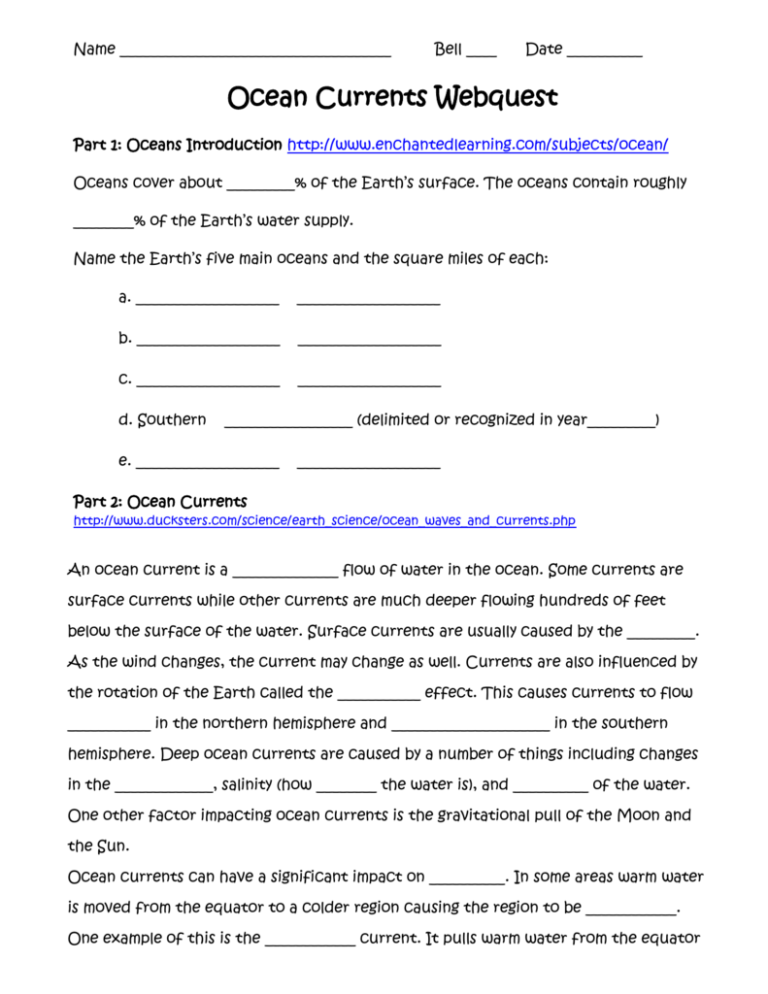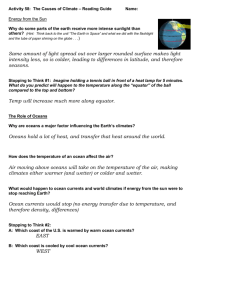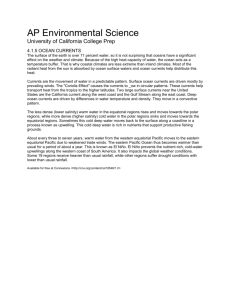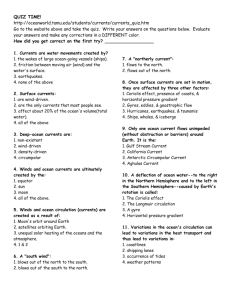Ocean Currents Web quest
advertisement

Name ____________________________________ Bell ____ Date __________ Ocean Currents Webquest Part 1: Oceans Introduction http://www.enchantedlearning.com/subjects/ocean/ Oceans cover about _________% of the Earth’s surface. The oceans contain roughly ________% of the Earth’s water supply. Name the Earth’s five main oceans and the square miles of each: a. ___________________ ___________________ b. ___________________ ___________________ c. ___________________ ___________________ d. Southern _________________ (delimited or recognized in year_________) e. ___________________ ___________________ Part 2: Ocean Currents http://www.ducksters.com/science/earth_science/ocean_waves_and_currents.php An ocean current is a ______________ flow of water in the ocean. Some currents are surface currents while other currents are much deeper flowing hundreds of feet below the surface of the water. Surface currents are usually caused by the _________. As the wind changes, the current may change as well. Currents are also influenced by the rotation of the Earth called the ___________ effect. This causes currents to flow ___________ in the northern hemisphere and _____________________ in the southern hemisphere. Deep ocean currents are caused by a number of things including changes in the _____________, salinity (how ________ the water is), and __________ of the water. One other factor impacting ocean currents is the gravitational pull of the Moon and the Sun. Ocean currents can have a significant impact on __________. In some areas warm water is moved from the equator to a colder region causing the region to be ____________. One example of this is the ____________ current. It pulls warm water from the equator to the coast of Western Europe. As a result, areas such as the United Kingdom are typically much __________ than areas at the same northern latitude in North America. Part 3: Coriolis Effect http://www.kidsgeo.com/geography-for-kids/0089-coriolis-effect.php The rotation of the Earth causes an interesting phenomena on free moving objects on the Earth. Objects in the Northern Hemisphere are deflected to the _______________, while objects in the Southern Hemisphere are deflected to the ________________. http://www.classzone.com/books/earth_science/terc/content/visualizations/es1904/es1 904page01.cfm?chapter_no=visualization In the 1st animation: The target location in the Northern Hemisphere where the plane was headed when it took off has moved with the Earth’s rotation, so the plane would end up to the ______________ of its original target. In the 2nd animation: The target location in the Southern Hemisphere where the plane was headed when it took off has moved with Earth's rotation, so the plane would end up to the ____________________ of its original target. Part 4: Upwelling http://www.classzone.com/books/earth_science/terc/content/visualizations/es2405/es2 405page01.cfm?chapter_no=visualization In this animation, winds blowing along the coast push the coastal surface water. When combined with the ______________________ _________________, this motion moves surface water away from the coast. As surface water moves outward, cold, planktonrich water from the ocean bottom moves toward the coast and ______________________ to replace the displaced surface water. Part 5: Wave Motion http://www.classzone.com/books/earth_science/terc/content/visualizations/es1604/es1 604page01.cfm?chapter_no=visualization When wave _____________________________ passes through water, the water moves in a _________________________ motion. Energy is passing from left to right in this animation, but the water itself stays in the _____________________ general location. Part 6: Ocean Currents and Global Wind http://oceanservice.noaa.gov/education/pd/oceans_weather_climate/media/ocean_and _wind_currents.swf To show the ocean currents and global wind patterns on Earth, click on the buttons at the bottom of the page. To see both at the same time, click on “Both Currents”. Use your observations to answer the following questions. 1. Name two observations you can make when looking at the ocean and wind currents. ______________________________________________________________________________ ____________________________________________ 2. Look at the direction of the surface currents in the oceans and at the direction of the wind. What evidence do you find that wind influences the direction of the surface currents in the oceans? ______________________________________________________________________________ ______________________________________________________________________________ ______________________________________________________________________________ __________ 3. Notice the location and flow of warm (red) and cold (blue) ocean currents. Why do you suppose that currents flowing toward the equator are generally cool while currents flowing away from the equator are warm? ______________________________________________________________________________ ______________________________________________________________________________ ______________________________________________________________________________ __________ Ocean Currents Webquest- Answer Key Part 1: Oceans Introduction Oceans Cover about 70% of the Earth’s surface. The oceans contain roughly 97% of the Earth’s water supply. Name the Earth’s five main oceans and the square miles of each: a. Pacific- 63,780,000 sq mi b. Atlantic- 41,080,000 sq mi c. Indian- 28,400,000 sq mi d. Southern- 7,848,000 sq mi (delimited or recognized in year 2000) e. Arctic- 5,400,000 sq mi Part 2: Ocean Currents Introduction An ocean current is a continuous flow of water in the ocean. Some currents are surface currents while other currents are much deeper flowing hundreds of feet below the surface of the water. Surface currents are usually caused by the wind. As the wind changes, the current may change as well. Currents are also influenced by the rotation of the Earth called the Coriolis effect. This causes currents to flow clockwise in the northern hemisphere and counterclockwise in the southern hemisphere. Deep ocean currents are caused by a number of things including changes in the temperature, salinity (how salty the water is), and density of the water. One other factor impacting ocean currents is the gravitational pull of the Moon and the Sun. Ocean currents can have a significant impact on climate. In some areas warm water is moved from the equator to a colder region causing the region to be warmer. One example of this is the Gulfstream current. It pulls warm water from the equator to the coast of Western Europe. As a result, areas such as the United Kingdom are typically much warmer than areas at the same northern latitude in North America. Part 3: Coriolis Effect The rotation of the Earth causes an interesting phenomena on free moving objects on the Earth. Objects in the Northern Hemisphere are deflected to the right, while objects in the Southern Hemisphere are deflected to the left. In the 1st animation: The target location in the Northern Hemisphere where the plane was headed when it took off has moved with the Earth’s rotation, so the plane would end up to the right of its original target. In the 2nd animation: The target location in the Southern Hemisphere where the plane was headed when it took off has moved with Earth's rotation, so the plane would end up to the left of its original target. Part 4: Upwelling In this animation, winds blowing along the coast push the coastal surface water. When combined with the Coriolis Effect, this motion moves surface water away from the coast. As surface water moves outward, cold, plankton-rich water from the ocean bottom moves toward the coast and rises to replace the displaced surface water. Part 5: Wave Motion When wave energy passes through water, the water moves in a circular motion. Energy is passing from left to right in this animation, but the water itself stays in the same general location. Part 6: Ocean Currents and Global Wind To show the ocean currents and global wind patterns on Earth, click on the buttons at the bottom of the page. To see both at the same time, click on “Both Currents”. Use your observations to answer the following questions. 1. Name two observations you can make when looking at the ocean and wind currents. Currents- the blue are heading south and the red are heading north Wind- blue going right and red going left 2. Look at the direction of the surface currents in the oceans and at the direction of the wind. What evidence do you find that wind influences the direction of the surface currents in the oceans? Generally, wind currents and ocean currents go in the same direction. Specifically, in the Pacific ocean off the coast of South America, there are both easterly winds and westerly winds and the currents in that area look like whirlpool (circle). 3. Notice the location and flow of warm (red) and cold (blue) ocean currents. Why do you suppose that currents flowing toward the equator are generally cool while currents flowing away from the equator are warm? The cold (blue) currents, are going toward they equator because they are bringing the cold water from the poles to be heated up. The warm (red) currents are going away from the equator because they are taking warm water to the poles, which keep the oceans near the poles from freezing.









